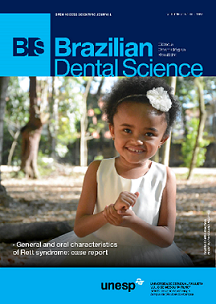Comparative analysis of plastic deformation of NiTi and CuNiTi wires submitted to mechanical cycling
DOI:
https://doi.org/10.14295/bds.2017.v20i3.1438Abstract
Objective: The aim of this study was to evaluate the plastic deformation of NiTi and CuNiTi archwires submitted to mechanical cycling. Material and Methods: Orthodontic archwires made of CuNiTi of five commercial brands (n=10) were used: RMO, Orthometric, Ormco, Aditek and Eurodonto; and a Control Group of NiTi archwire: Aditek thermoactivated. All the archwires, with caliber 0.016”, were fitted into the slots of four conventional brackets, aligned and fixed to an acrylic plate. The test was performed by applying a load of 3 N and frequency of 2 Hz between the most central brackets, limited to 10,000 cycles. After cycling, the presence or absence of archwire fracture was observed. When there was no fracture, the archwires were analyzed relative to plastic deformation with the use of a transferer, measuring the angulation of the deformed archwire. Results: The results showed that there was no fracture in any of the wires analyzed. The Kruskal-Wallis test showed differences among the angulations of the orthodontic archwires (p=0.0009). With exception of the Ormco wires, the other types presented plastic deformation. The highest median of the angulation value was observed for the Aditek Copper NiTi archwire. The lowest median values were observed for the RMO, Eurodonto and Ormco archwires. The Aditek thermoactivated and Orthometric archwires presented intermediate angulation. Conclusion: None of the archwires analyzed presented fracture. These archwires presented differences in plastic deformation, irrespective of the presence of copper in their chemical composition. The Ormco archwire was the only type that presented no deformation whatever.
Keywords
Mechanical cycling; Copper; Deformation; Orthodontic wires; Fracture.
Downloads
Downloads
Published
How to Cite
Issue
Section
License
Brazilian Dental Science uses the Creative Commons (CC-BY 4.0) license, thus preserving the integrity of articles in an open access environment. The journal allows the author to retain publishing rights without restrictions.
=================




























